The extraordinary Catherrine Lundoff recently posted her 2012 Writing Year in Review and an admirably productive year it was for her. Be sure to check out her many amazing new works, including a well-reviewed novel, which, incidentally gets mentioned obliquely in my poem "The Dream Highway of Ms. Mannivongsa." That poem is appearing in my forthcoming book DEMONSTRA along with a poem regarding Catherine and Peg Powler powling about in those pages.)
As I have only a handful of hours left in the day and many, many, many errands to run, including a turducken in the oven, I'm obliged to say that in regards to my own year in writing, it was big. Really big. And fun. Thanks to all of you. :) As I hit the Big 40, I got most of the items marked off of my bucket list, and set in motion many exciting things for the Year of the Snake coming up ahead. I had a few surprises, a few challenges, but more than enough triumphs to make up for it.
From the Olympics to new books and publications in many, many journals, being a guest at the H.P. Lovecraft Film Festival, and inventing a new holiday, Lao Minnesotan Artists Heritage Month (precursor to the first National Lao American Artists Heritage Month next year), I think we can call that a year's work.
So, cheers, well wishes, and as I mentioned elsewhere, my advice going into the next year is: Apple carts are made to be emptied. "How" is where the art comes in.
Make it exceptional!
Poetry, science fiction, fantasy, horror, and culture from a Lao American perspective.
Monday, December 31, 2012
Friday, December 28, 2012
[Horror] Lao Ancients and Old Ones up at Innsmouth Free Press
My lastest article, Lao Ancients and Old Ones: An Introduction to Writing Lovecraftian Lan Xang was recently posted at Innsmouth Free Press and as my last article for the year there seems a good way to cap things off before I start up my new regular column over there for 2013.
In this article, I posit that readers "can accept rampaging orcs, hobbits, and great Cthulhu himself. So, an able writer should be able to present epics set in ancient Lane Xang as heroes live by their wits and a big, sharp dap nyai."
In this article, I posit that readers "can accept rampaging orcs, hobbits, and great Cthulhu himself. So, an able writer should be able to present epics set in ancient Lane Xang as heroes live by their wits and a big, sharp dap nyai."
This of course remains the constant challenge for the Lao horror writer. We should be making our own legends and fantastic realms, for we have centuries of material that could rival Conan or the Lord of the Rings, but we must also be pushing forward new myths and new legends for the next age as well, if we are to create work that endures, not just makes a profit.
There's a wide range of material and issues I had to leave out for this article, but I hope it gets some of the more salient points across and encourages readers and writers to look for the imaginative work of the Lao, not just memoirs and histories.
While I think there's a space for these in every culture, if we remain fixated merely on the past, we cannot begin to articulate a present. Nor can we pass on interesting ideas to the next generation that can speak of a greater Laos, the kind that might one day reach stars and new planets. That's why I think the work of directors like Mattie Do or playwrights like Saymoukda Vongsay or K.P. Phagnasay will become so crucial in this generation to avoid locking us into the old cliches and tropes or, worse, an appalling century of mediocre art.
Monday, December 24, 2012
Forest hermits of Laos
Lao tradition features many tales of the forest hermits who often help guide heroes and other people along the way to fulfill their quests. The raiments made from tiger pelts has always been intriguing to me, given the relationship of tigers to other traditions in Lao myth.You don't see these images in every temple, but when you do, it's intriguing.
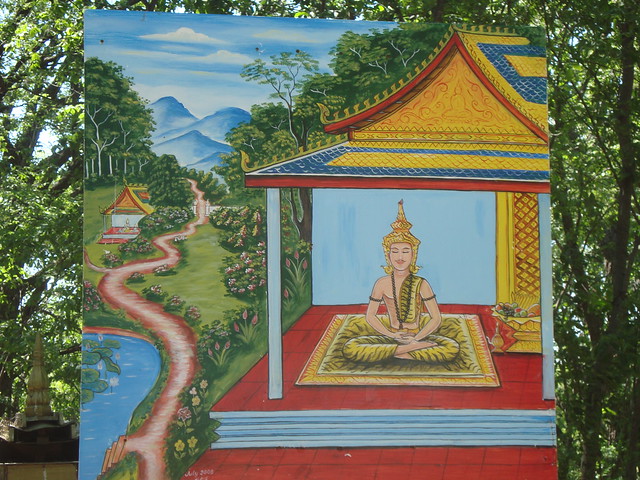


Friday, December 21, 2012
DEMONSTRA Kickstarter cover preview!
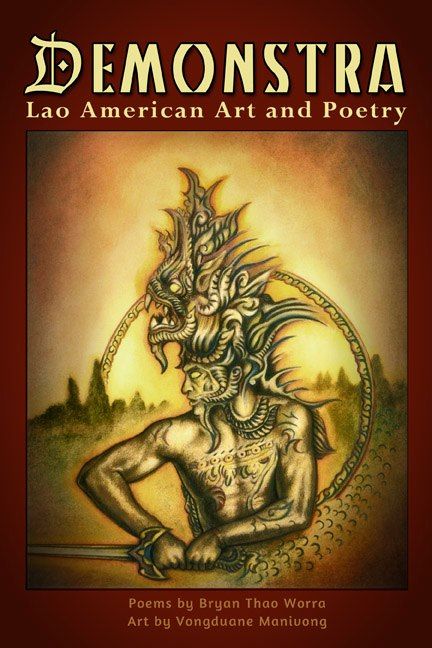
Vongduane Manivong recently finished the preliminary design for the exclusive Kickstarter edition of the cover for DEMONSTRA. This will be different from the art used for the Innsmouth Free Press edition. There will be a few last-minute tweaks and adjustments, but this is very close to what the final will look like.
Backers who get a postcard will be getting a copy of this image (in its final form). In addition, those who get a poster will be getting an 18" x 24" version because we met our $2,000 stretch goal. The Kickstarter is still going on until January 1st at: http://www.kickstarter.com/projects/thaoworra/demonstra-lao-american-art-and-poetry
All of our backers get an e-preview of some of the poems included in DEMONSTRA. You can currently go see it at slideshare at: http://www.slideshare.net/thaoworra/demonstra-preview-2012
Thursday, December 20, 2012
Miss Minnesota helping Lao children

Miss Minnesota USA, Nitaya Panemalaythong, was invited by the U.S. Embassy in Laos. The goal of her trip is "to help promote business, charitable, and cultural ties between Laos and the U.S."
Sponsored by the American Chamber of Commerce (AMCHAM) for January 13-27, 2013, she is asking community members to consider making a donation to this special opportunity. It's a tight deadline to work with, but often that's the hand people get dealt when working on issues of international development.
The organizations she's visiting are in need of "school supplies, hygiene materials, toys, shoes, clothes and international shipping services." Monetary donations are also welcomed, and honestly, I think more helpful, to help purchase the items listed, and to assist the staff of the schools, orphanages and non-profits she'll be visiting. She'd be able to get better prices in Southeast Asia and reduce the overall transit costs compared to trying to pack them in the US and take them with her and waiting for them to clear customs.
If you can help Nitaya on her effort to give back to the children of Laos, even just a few dollars it will help. $5 (A cup of coffee or a modest lunch in America) turns into 39,800 kip in Laos. Only 63% of the girls in Laos can read. Nitaya is visiting groups trying to change that and to give them more opportunities for a brighter future.

Even $5 helps to keep the lights and power on at the schools for a day (although, honestly, $20 or even $100 goes a lot further, as you know.) $10 a month would be $120 but imagine how far that would go in Laos (955,500 kip, if you're curious.)
She will be working with the charity Peuan Mit. Supported by the U.S. Embassy, the staff and volunteers of Peuan Mit provide counseling and support to Lao street children who have limited opportunities. She will also visit remote villages near Luang Prabang with the non-profit organization Pencils of Promise.
Miss Panemalaythong will also visit the Vientiane Youth Center for Health and Development, an organization "that does incredible work with Lao teenagers." I'm very impressed by the outpouring of support for her so far. It's not often we also see a Miss Minnesota rising up to the occasion and taking a place on the international stage.
Miss Panemalaythong was born in the refugee camps of Thailand, so her taking this first trip, and where she goes from this point forward ought to be very interesting.
I think it would be worthwhile to assist her on her first trip back. For me, this is the 10th anniversary since my first trip back to Laos after 30 years, and I can honestly say that trip changed the entire direction of my life in a meaningful and positive way. I hope her journey will be just as positive as my first trip was. Who knows where she'll be, 10 years from now. But let's do our best to help her get off to a good start.
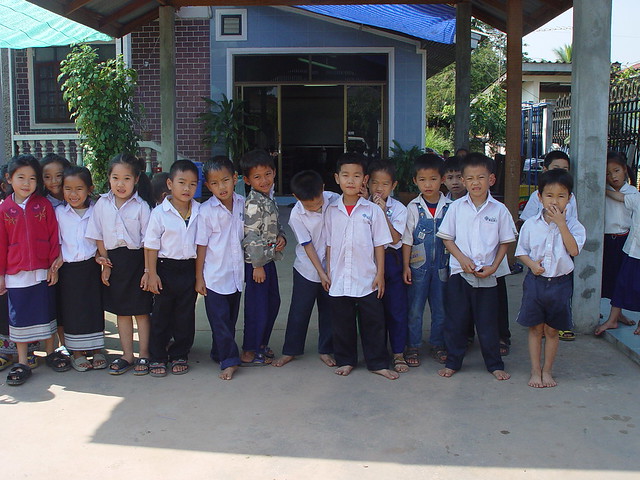
I would hope she continues to go on to advocate for her community and to connect with other Lao expatriates around the world to change things for the better. Dr. Ketmani Kouanchao recently reflected on her first trip back while also encouraging Miss Panemalaythong over at Little Laos on the Prairie. It's an article well worth reading to get some perspective on the issue.
As far as positive learning experiences go, I think she's chosen wisely in this instance, and I have high hopes for her in the future and her ability to bring attention to the positive causes that need help most.
You can visit the site listed (http://www.gofundme.com/hok38) to make your donation. As we said above, any amount helps.
They are hoping to reach $5,000 to support children in Laos, which would convert to 39,812,519 kip. That seems very doable given the 200,000+ Lao in the US, and so many more around the world, and I think would set a great example of Lao commitment to charitable causes.
Chanthaly Lao horror film taking off
Is Chanthaly finally starting to get traction? It was recently covered at Twitch.
Chanthaly stands out as the first Lao horror film, and the first Lao film directed by a woman, Mattie Do. It made an impression on viewers at the Luang Prabang Film Festival recently.
The plot synopsis has been: "Raised alone by her overprotective father sequestered in their home in Vientiane, Chanthaly suspects that her dead mother's ghost is trying to deliver a message to her from the afterlife. After a change in her medication, intended to treat her hereditary heart condition, causes the hallucinations to cease, Chanthaly must decide whether or not to risk succumbing to her terminal illness in order to hear her mother's last words."
Will Lao horror go on to be on par with films like Shutter, The Ring, or The Grudge? Will we see a focus on fearful topics from a Lao perspective or will they aim for more marketable, accessible tales that eschew authentic Lao culture? It would appear Chanthaly is getting us off on the right foot. As many know, I didn't particularly find Uncle Boonmee Who Can Recall His Past Lives satisfying because I could appreciate what he was trying to do as an artist, but as whole, it left me cold. But this looks promising.
The poster's a little overcrowded with sponsor logos, but it also suggests some interesting things about the modern Lao movie-making process at the moment and the marketing aesthetics. I suppose the end question is: Will it get people into seats? Time will tell.
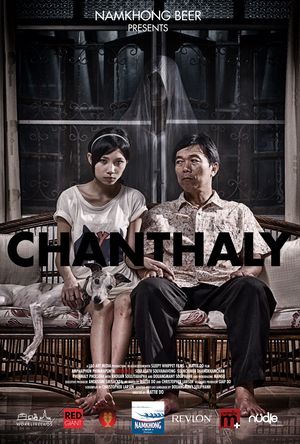
No trailers have been presented for Chanthaly yet, but I'm looking forward to seeing it when the opportunity presents itself.
Chanthaly stands out as the first Lao horror film, and the first Lao film directed by a woman, Mattie Do. It made an impression on viewers at the Luang Prabang Film Festival recently.
The plot synopsis has been: "Raised alone by her overprotective father sequestered in their home in Vientiane, Chanthaly suspects that her dead mother's ghost is trying to deliver a message to her from the afterlife. After a change in her medication, intended to treat her hereditary heart condition, causes the hallucinations to cease, Chanthaly must decide whether or not to risk succumbing to her terminal illness in order to hear her mother's last words."
Will Lao horror go on to be on par with films like Shutter, The Ring, or The Grudge? Will we see a focus on fearful topics from a Lao perspective or will they aim for more marketable, accessible tales that eschew authentic Lao culture? It would appear Chanthaly is getting us off on the right foot. As many know, I didn't particularly find Uncle Boonmee Who Can Recall His Past Lives satisfying because I could appreciate what he was trying to do as an artist, but as whole, it left me cold. But this looks promising.
The poster's a little overcrowded with sponsor logos, but it also suggests some interesting things about the modern Lao movie-making process at the moment and the marketing aesthetics. I suppose the end question is: Will it get people into seats? Time will tell.

No trailers have been presented for Chanthaly yet, but I'm looking forward to seeing it when the opportunity presents itself.
Emerging Lao American Director: Nakhone Keodara
Nakhone Keodara has been a vocal presence in the Lao American community for many years, taking a journey that can easily be described as labyrinthine at times. But there's no doubt of his earnest pursuit of the arts, whether it's projects like Roses and Red Ants, or his new short, Black Swan, which was posted online recently at Vimeo: http://vimeo.com/55485364 Be sure to give him some feedback and keep an eye out for his future projects.
Pondering weretigers of Laos

Of significant interest are the beliefs among several of the Lao Soung tribes in the mountains of Laos. Weretigers are common supernatural concerns in this area.
In "Peoples of the Golden Triangle," Paul and Elaine Lewis noted the Akha erect a gate with protective wooden figures to “protect the village from hawks and wildcats, leopards and tigers, illness and plague, leprosy and epilepsy, vampires and weretigers, and all other bad and wicked things’. (Lewis, p. 224)
Lewis also examined Lisu beliefs. The Lisu historically have believed weretigers (phi pheu) and 'vampires' (phu seu) were capable of possessing others, and that family members of the possessed were capable of becoming possessed as well. This affected courtship practices, including Lisu youth wishing to avoid courting people who came from villages where someone had been possessed by a weretiger. (Lewis, 260.)
A particularly distinctive belief among the Lisu is that “Sometimes a possessed person causes the essence of the weretiger to go into some valuable object, such as a silver ornament or a piece of fine fabric, and leaves it lying on a path. Anyone who picks up that object will in turn be possessed by the weretiger.” (Lewis, 260.)
Lewis further noted that to Lisu, “A person possessed by a vampire (phu seu) takes the shape of a cat, a dog, or some other animal, and goes around biting and sucking the blood of people and animals, both the living and the newly dead. On the morning after a Lisu corpse has been buried someone goes to the grave and shoots a gun over it, and the tells the deceased, ‘the vampire is dead’. Lisu believe that if there is a vampire in a village many children will die.” (Lewis, 260) This has had an effect on the way they engage with doctors and physicians. “In the past Lisu were not willing to take their sick to hospitals, fearing that they might be bitten by ‘vampires’, for they believe wherever many people are sick and dying, vampires must be present.” (Lewis, 266)
Another community examined were the Lahu. There are approximately 10,000 Lahu in Laos. Lahu believe in spirits known collectively as ne. Some are beneficial or neutral, but some are vicious and known to attack others if they are offended. “Spirits capable of invading people are greatly feared. When possession takes place, they must be exorcised.” (Lewis, 192) Lewis notes that ‘Lahu are very concerned about weretigers (taw) trying to get to the corpse. If they hear mysterious noises, or see many insects near the grave soon after the burial, they fear that a weretiger may be lurking about. Relatives sometimes wait by the grave with machete in hand ready to attack any weretiger which might try to molest the body.” (Lewis, 192)
The Mien cosmology is a unique blend of Taoism learned over five hundred years ago that also integrates animist beliefs in the spirits and ancestors. Mien recognize the spirits as “beings who live in a world opposite to that of people; they work at night, while humans work in the day; they are stupid while people are clever; and they are strong, while humans are weak.” (Lewis, 156-157) Mien have a society of priests and shamans. Lesser priests “deal only with the ‘small spirits under the sky’, the evil and often malicious spirits which need to be controlled in order to avoid sickness and misfortune.” (Lewis, 161)
More remains to be studied.
Wednesday, December 19, 2012
[Poem] Silosoth’s Secret Roads to Himapan
Silosoth’s Secret Roads to Himapan
Read carefully,
There are at least seven secret roads
To fabled Himapan Forest through timeless Laos
Since the nights before Lane Xang and Fa Ngum.
Several routes beyond these are known, some unique,
Opening to a certain watchful eye when the stars are right.
At least one follows the flow of a sacred river,
One lurks within a fractured isle full of fear,
Another, a secluded beach of bleached bones you know
By behemoth buzzards and a dancing ocean of acid.
If you take the journey, bring provisions, seek wisdom.
Be prepared to wander a lifetime.
It is beyond belief how easily you can get sidetracked
Before you even reach the gateless gate.
Suspend assumptions and ego, anchoring you
To ordinary worlds without escape, missing exits
Plain as a fragrant dok champa by the same road
Of profound old Buddhas and young nak princes,
Crafty farmers, lovely kinnaly and compassionate vets.
There are no signs to assure you, and many leaps to make.
Squeezing through caverns, drinking from strange wells,
Someone has been at least that far before, once, seeking.
But doubt is a poisoned golden dagger, honed for you,
A jade cup of surrender and apologies in 10,000 tongues.
Curiosity can sustain.
A good laugh might summon a brave vanon with time enough
To point part of the way, if they aren’t full of mischief that day,
Laughing like Xieng Mieng or some green koala.
Hermits and hunters have found hidden nooks and vales.
True lovers can spot the easiest of the trails but there are trials:
Horrors of hostile titanic elephants, saber-toothed catfish,
Nefarious nyak loitering with bad maps and empty bellies.
Riddles meant for heroes and heroines are labyrinths
There are no true words for.
But if you really arrive, they shall sing songs of you.
Some might offer you the wild heart of a lotus to eat,
Or a delicious dish of sukara-maddava best avoided.
You might be entranced by a wondrous naree pon.
Some will challenge you, convinced you will not stay.
Others want to judge you at the holy peak of Mount Meru,
Claiming even Phou Ngeun Kailath cannot save you.
You cannot catalog the many wandering within these woods:
One leg, two legs, three legs, four legs, five legs,
Six legs, seven legs, eight legs, infinitely more, and none.
Some with wings, with hooves, or the strangest toes,
Tentacles, tusks, talons or tendrils for your tales.
Some part bird, part deer, or part fish or kraken.
Some part cloud, part kirin, part elephant or lean lion.
Some part star, part rhino, or part thundering horse.
Some part cow, part dog, part cat, or part cranky crab.
Some part crocodile, part nak, or part frail human.
Some part learned monkey, part ram, or part slime.
Some part fungi, part bug, or part squamous snake.
Some part tyger, part white rabbit, or part quirky rat.
Some are all of the above, or none.
Some stay the same like living mountains,
Others are never met the same way twice.
You can ask them their true name.
Once in a while, they’ll give it to you.
You can ask some for a ride back,
Or a ride forward.
There might be a price in any case.
Incidentally, if you make it after all we’ve said,
There is a simple sala in one quiet corner,
Where you can rest your dreaming head
For a moment.
If you peek closely, you might find a certain name,
And a last bit of advice before you finish your adventure.
Laos is, Laos was, Laos will be,
But sometimes you will not recognize it
Or the endless sea of your eternal self,
Returning to cosmic cycles to begin again
Unless you
Read carefully,
There are at least seven secret roads
To fabled Himapan Forest through timeless Laos
Since the nights before Lane Xang and Fa Ngum.
Several routes beyond these are known, some unique,
Opening to a certain watchful eye when the stars are right.
At least one follows the flow of a sacred river,
One lurks within a fractured isle full of fear,
Another, a secluded beach of bleached bones you know
By behemoth buzzards and a dancing ocean of acid.
If you take the journey, bring provisions, seek wisdom.
Be prepared to wander a lifetime.
It is beyond belief how easily you can get sidetracked
Before you even reach the gateless gate.
Suspend assumptions and ego, anchoring you
To ordinary worlds without escape, missing exits
Plain as a fragrant dok champa by the same road
Of profound old Buddhas and young nak princes,
Crafty farmers, lovely kinnaly and compassionate vets.
There are no signs to assure you, and many leaps to make.
Squeezing through caverns, drinking from strange wells,
Someone has been at least that far before, once, seeking.
But doubt is a poisoned golden dagger, honed for you,
A jade cup of surrender and apologies in 10,000 tongues.
Curiosity can sustain.
A good laugh might summon a brave vanon with time enough
To point part of the way, if they aren’t full of mischief that day,
Laughing like Xieng Mieng or some green koala.
Hermits and hunters have found hidden nooks and vales.
True lovers can spot the easiest of the trails but there are trials:
Horrors of hostile titanic elephants, saber-toothed catfish,
Nefarious nyak loitering with bad maps and empty bellies.
Riddles meant for heroes and heroines are labyrinths
There are no true words for.
But if you really arrive, they shall sing songs of you.
Some might offer you the wild heart of a lotus to eat,
Or a delicious dish of sukara-maddava best avoided.
You might be entranced by a wondrous naree pon.
Some will challenge you, convinced you will not stay.
Others want to judge you at the holy peak of Mount Meru,
Claiming even Phou Ngeun Kailath cannot save you.
You cannot catalog the many wandering within these woods:
One leg, two legs, three legs, four legs, five legs,
Six legs, seven legs, eight legs, infinitely more, and none.
Some with wings, with hooves, or the strangest toes,
Tentacles, tusks, talons or tendrils for your tales.
Some part bird, part deer, or part fish or kraken.
Some part cloud, part kirin, part elephant or lean lion.
Some part star, part rhino, or part thundering horse.
Some part cow, part dog, part cat, or part cranky crab.
Some part crocodile, part nak, or part frail human.
Some part learned monkey, part ram, or part slime.
Some part fungi, part bug, or part squamous snake.
Some part tyger, part white rabbit, or part quirky rat.
Some are all of the above, or none.
Some stay the same like living mountains,
Others are never met the same way twice.
You can ask them their true name.
Once in a while, they’ll give it to you.
You can ask some for a ride back,
Or a ride forward.
There might be a price in any case.
Incidentally, if you make it after all we’ve said,
There is a simple sala in one quiet corner,
Where you can rest your dreaming head
For a moment.
If you peek closely, you might find a certain name,
And a last bit of advice before you finish your adventure.
Laos is, Laos was, Laos will be,
But sometimes you will not recognize it
Or the endless sea of your eternal self,
Returning to cosmic cycles to begin again
Unless you
Tuesday, December 18, 2012
Next Big Thing Interview!
Today I am taking part in the networked blog interview, The Next Big Thing. I was nominated last week by poet Kristine Ong Muslim
1) What is the working title of your next book?
DEMONSTRA
2) Where did the idea come from for the book?
It was originally conceived as a followup to an earlier, hard-to-find chapbook of mine, MONSTRO, but like most literary ideas, spiraled away from there.
3) What genre does your book fall under?
Poetry, mostly, and beyond that we start getting into a quibbling of categories. Lao, Lao American, American, Asian American, Gen X., Speculative, Horror, Weird, Lovecraftian, Fantastic, etc.
4) What actors would you choose to play the part of your characters in a movie rendition?
I hadn't given too much thought to that, but Ova Saopeng and Lidet Viravong would be in the running, as would Kulap Vilaylack.
5) What is the one-sentence synopsis of your book?
DEMONSTRA is a poetic meditation on what is shown and what is learned, what we fear, and what we see.
6) Will your book be self-published or represented by an agency?
I'll be published through Innsmouth Free Press, but they've given me a lot of latitude.
7) How long did it take you to write the first draft of the manuscript?
About a month, but the revisions have been going on for six months now.
8) What other books would you compare this story to within your genre?
I wouldn't want to over or undersell the text. But I think it would fit in firmly among my peers' work.
9) Who or what inspired you to write this book?
Approaching my 40th birthday, I still hadn't really seen the book I wanted to read, the one that was examining and exploring not just who we are and who we were, but where we were headed as Lao Americans, both internally and externally.
10) What else about the book might pique the reader's interest?
I'll be working with the Lao American artist Vongduane Manivong who will be providing several modernized interpretations of many of the classic beings of Lao and Southeast Asian mythology.
Now, I'm obliged to tag five other authors, so, I'm starting off tagging:
Nicholas Almand: http://www.sonsofnowhere.com
But apparently most of my other colleagues have already done this interview already...
Hopefully they'll have something neice and juicy for you soon!
1) What is the working title of your next book?
DEMONSTRA
2) Where did the idea come from for the book?
It was originally conceived as a followup to an earlier, hard-to-find chapbook of mine, MONSTRO, but like most literary ideas, spiraled away from there.
3) What genre does your book fall under?
Poetry, mostly, and beyond that we start getting into a quibbling of categories. Lao, Lao American, American, Asian American, Gen X., Speculative, Horror, Weird, Lovecraftian, Fantastic, etc.
4) What actors would you choose to play the part of your characters in a movie rendition?
I hadn't given too much thought to that, but Ova Saopeng and Lidet Viravong would be in the running, as would Kulap Vilaylack.
5) What is the one-sentence synopsis of your book?
DEMONSTRA is a poetic meditation on what is shown and what is learned, what we fear, and what we see.
6) Will your book be self-published or represented by an agency?
I'll be published through Innsmouth Free Press, but they've given me a lot of latitude.
7) How long did it take you to write the first draft of the manuscript?
About a month, but the revisions have been going on for six months now.
8) What other books would you compare this story to within your genre?
I wouldn't want to over or undersell the text. But I think it would fit in firmly among my peers' work.
9) Who or what inspired you to write this book?
Approaching my 40th birthday, I still hadn't really seen the book I wanted to read, the one that was examining and exploring not just who we are and who we were, but where we were headed as Lao Americans, both internally and externally.
10) What else about the book might pique the reader's interest?
I'll be working with the Lao American artist Vongduane Manivong who will be providing several modernized interpretations of many of the classic beings of Lao and Southeast Asian mythology.
Now, I'm obliged to tag five other authors, so, I'm starting off tagging:
Nicholas Almand: http://www.sonsofnowhere.com
But apparently most of my other colleagues have already done this interview already...
Hopefully they'll have something neice and juicy for you soon!
Monday, December 17, 2012
Call for 2012 Rhyslings
The Science Fiction Poetry Association calls for the best science fiction, fantasy, and horror poetry published in 2012. Members and nonmembers are eligible for the Rhysling Poetry Award, but only current members can make nominations (from January 1 to February 15, 2013, inclusive). Please carefully read the guidelines found here: http://www.sfpoetry.com/ra/rhysnom.html.
For those of you who are curious, for me, the clearly eligible works of mine that could be nominated from 2012 are:
"Dead End in December," Innsmouth Free Press, December 2012. http://www.innsmouthfreepress.com/blog/?p=19819
"Idle Fears" Buddhist Poetry Review, September, 2012 http://www.buddhistpoetryreview.com/archives/issue-six/bryan-thao-worra
"What is the Southeast Asian American Poem of Tomorrow?" Angry Asian Man, August, 2012 http://blog.angryasianman.com/2012/08/angry-poetry-corner-what-is-southeast.html
"Bangkok Arrival," Toe Good Poetry, August, 2012
http://toegoodpoetry.com/2012/08/bryan-thao-worra-2/
"Metropolis" Toe Good Poetry Journal, February, 2012
http://toegoodpoetry.com/2012/02/bryan-thao-worra/
For those of you who are curious, for me, the clearly eligible works of mine that could be nominated from 2012 are:
"Dead End in December," Innsmouth Free Press, December 2012. http://www.innsmouthfreepress.com/blog/?p=19819
"Idle Fears" Buddhist Poetry Review, September, 2012 http://www.buddhistpoetryreview.com/archives/issue-six/bryan-thao-worra
"What is the Southeast Asian American Poem of Tomorrow?" Angry Asian Man, August, 2012 http://blog.angryasianman.com/2012/08/angry-poetry-corner-what-is-southeast.html
"Bangkok Arrival," Toe Good Poetry, August, 2012
http://toegoodpoetry.com/2012/08/bryan-thao-worra-2/
"Metropolis" Toe Good Poetry Journal, February, 2012
http://toegoodpoetry.com/2012/02/bryan-thao-worra/
Considering the Kickstarter edition of DEMONSTRA
For comparison's sake, the Kickstarter edition of DEMONSTRA will be 6 x 9 inches, the same size as "The Heart, A Brush. The Soul, An Eye." The regular edition from Innsmouth Free Press will be the same size as the first edition of On The Other Side Of The Eye, or 5 x 8 inches.
You can see the difference this would make in terms of the size of the art that will be included from Vongduane Manivong when it is published next year. Images would be larger and the text would have more space to 'breathe' on the page.
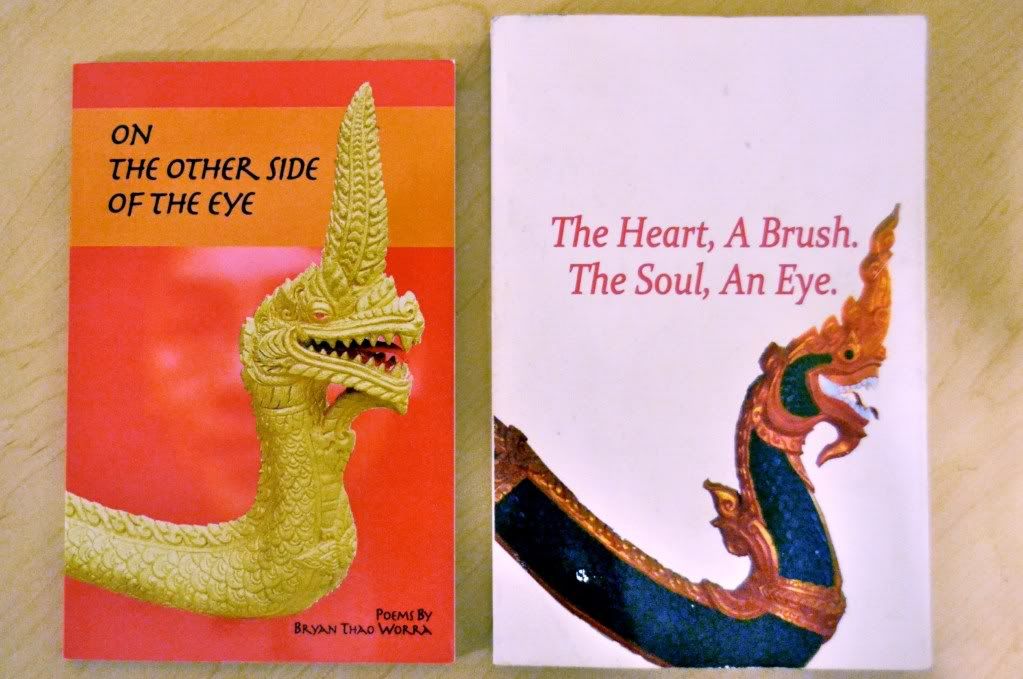
You'll only be able to get the Kickstarter edition through the pre-order period going on for the next 14 days. Once the period is over, it's over, and you'll only be able to get the regular edition, otherwise. Which will still be an excellent edition, but it will have a completely different cover and be smaller overall.
You can see the difference this would make in terms of the size of the art that will be included from Vongduane Manivong when it is published next year. Images would be larger and the text would have more space to 'breathe' on the page.

Sunday, December 16, 2012
Art in progress: The Nakanya

Vongduane Manivong presented some preliminary art for the Nakanya who will appear in my new book, DEMONSTRA coming in April, 2013 from Innsmouth Free Press. This isn't the final, but I hope it gives you some sense of where we're taking the book. We're very excited about this project.
This was funded in part by your support through our kickstarter at http://www.kickstarter.com/projects/1064450543/demonstra-lao-american-art-and-poetry which is entering its last two weeks.
This was funded in part by your support through our kickstarter at http://www.kickstarter.com/projects/1064450543/demonstra-lao-american-art-and-poetry which is entering its last two weeks.
We hope to raise additional funds during this time to commission the last 8 beings we wanted to present for this project, namely the Weretiger,
Mae Thorani, Phi Kowpoon, the noodle-selling girl ghost, the flying steed Manikab, the Kinnon, the Toad King Khankak, Phi Kongkoi, the hungry ghost, and the Chameleon Prince Khangkham.
For those of you who are curious, one of the prominent mentions of the Nakanya is regarding the eight-year-old daughter of Sagara, one of the eight great nak kings said to dwell in a palace at the bottom of the sea.According to the "Devadatta" chapter of the Lotus Sutra, the nakanya conceived the desire for enlightenment when she heard the Bodhisattva Manjusri preach the Lotus Sutra in the nak king's palace. It's notable that this led into an argument between her and the disciple Shariputra, who insisted a woman cannot attain nirvana. She put him in his place faster than a human can blink, and opened the way for women across the universe, according to tradition.
Unfortunately, European and American translators often refer to such beings as 'dragon princesses' which really doesn't do them justice. It's not really any more an accurate term than calling Medusa a hag or a witch, or a basilisk a dragon. Is a Zaj a Naga or a Nak, a Lung or a Ryu? Some may think we should consider the terms interchangeable, but I would disagree.
Thursday, December 13, 2012
Crowdfunding Lao American Imagination
A post I'd done recently on crowdfunding the Lao American imagination for Little Laos on the Prairie got picked up by the Twin Cities Daily Planet this week. In it I address a number of topics ranging from kickstarter to hobbits, ancient Lao myths and speculative poetry. Check it out, if you get a chance: http://www.tcdailyplanet.net/blog/bryan-thao-worra/crowdfunding-lao-american-imagination


Lao American writer Chay Douangphouxay featured in Asian American Press
Writer Chay Douangphouxay’s chapbook, Remission: Finding Light in the Midst of Social Darkness, is being published with a release party on Saturday, Dec. 15, 2012, from 6 to 8:30 p.m. at the Regla De Oro Art Gallery, 3007 Lyndale Ave South, in Minneapolis.

The poems in this collection are inspired by the life and experiences of the author from her humble beginnings in the Thai refugee camps to growing up as a second-class citizen in the Housing Projects of North Minneapolis. You can learn more at Asian American Press.

Wednesday, December 12, 2012
Tuesday, December 11, 2012
One Month Left Until the APIASF Scholarship Deadline
The Asian & Pacific Islander American Scholarship Fund (APIASF), the nation's the nation's largest nonprofit organization devoted to providing college scholarships for Asian Americans and Pacific Islanders, is accepting applications for the 2013 - 2014 scholarship cycle.
Scholarships are available for high school seniors, GED earners, and currently enrolled college freshmen, sophomores or juniors.
Awards range from $2,500 to $10,000. All applications must be submitted by Friday, January 11, 2013 at 11:59 p.m. EST. Late applications will not be considered. Apply here: https://secure.apiasf.org/
Scholarships are available for high school seniors, GED earners, and currently enrolled college freshmen, sophomores or juniors.
Awards range from $2,500 to $10,000. All applications must be submitted by Friday, January 11, 2013 at 11:59 p.m. EST. Late applications will not be considered. Apply here: https://secure.apiasf.org/
Friday, December 07, 2012
[Poem] Dead End in December
Featured over at Innsmouth Free Press this month! And it will also appear in my new book, DEMONSTRA, in 2013.
Thursday, December 06, 2012
[Poem] Dragon Fruit, Morning Market
A dragon fruit ponders her fine skull,
Flesh roars garishly, seed germinating
Rife with succulent promise.
Rife with succulent promise.
This mere box of a particolored cosmos,
A cooling square
Ready to ambush gargantuan frogs,
Collapsing on everything
The little deaths,
From saint to slug,
Midmorning philosopher,
The little deaths,
From saint to slug,
Midmorning philosopher,
Mothers of demons,
Trains of thought,
Forests are a verdant oraboros
Primal, smoking, orgiastic, still finite
Primal, smoking, orgiastic, still finite
So long a witness
How can it be surprised at an end
That is not an ending any more than
A fruit can be sold for her true worth.
DEMONSTRA Deluxe Edition: Commissioning the Nak
Thanks to everyone's support, we're now just $50 away from being able to commission a Lao American interpretation of the Nak for the deluxe edition of DEMONSTRA.
Also, if we make it to this goal, everyone who's pledged $20 or more will be getting six postcards in the oversized format! Rather than the standard 5.47" x 4.21", the postcards will now be 8.5" x 5.47"
While many of you are familiar with what a Nak is, for our new readers, the Nak, or Naga, is a famous guardian spirit found at temples throughout Laos, who are believed to dwell underground or in pristine waters. Normally, they appear as giant, serpentine entities, but they can also change shape, and have been known to appear as humans and other beings as the occasion requires.
You can find an amazing variety of interpretations of Nak around the world, so we're very excited to see how Vongduane will interpret them. To give you some sense of the extraordinary variety possible, here are some photos of Lao Nak I've taken from across Laos and the United States:
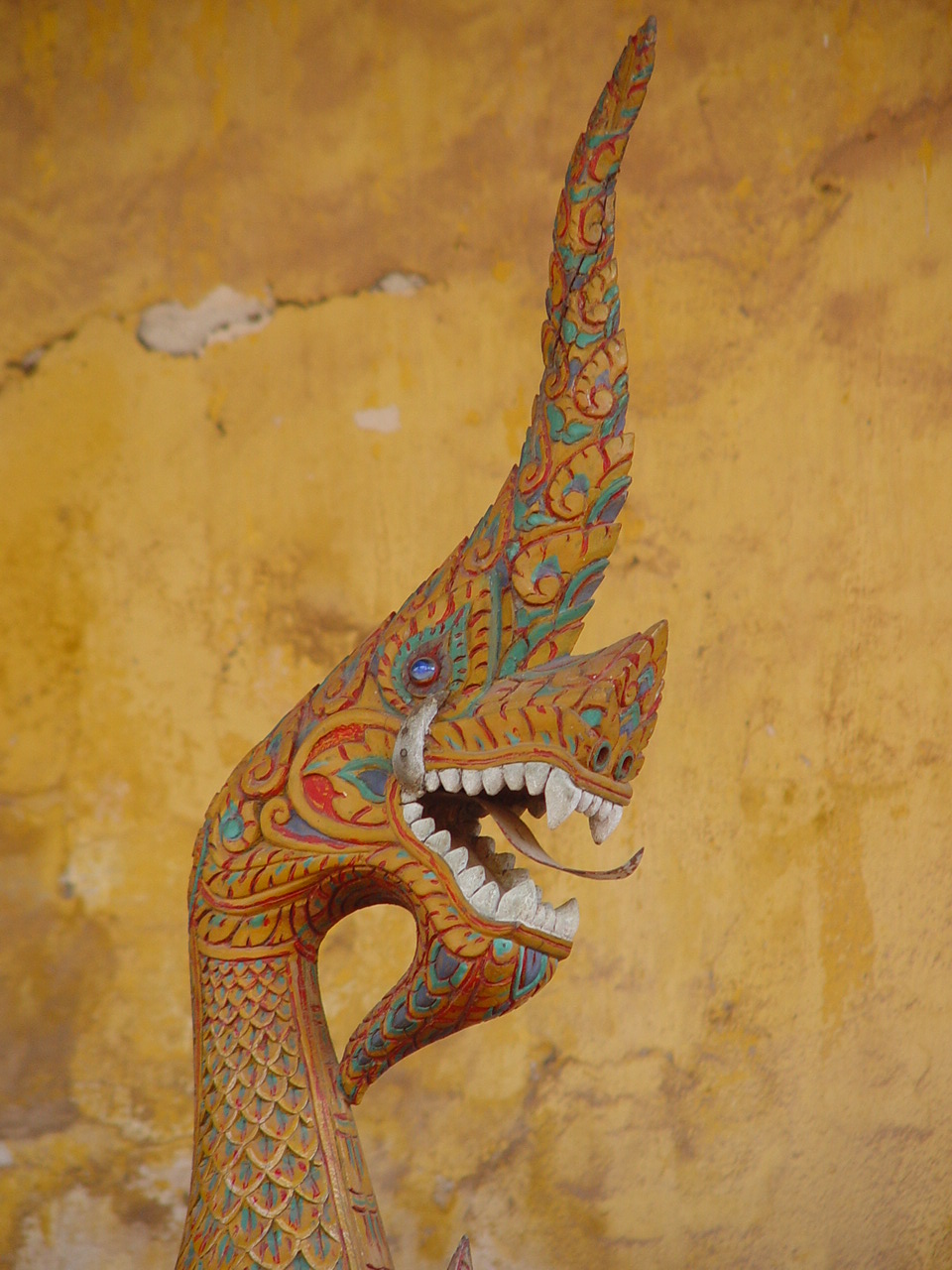
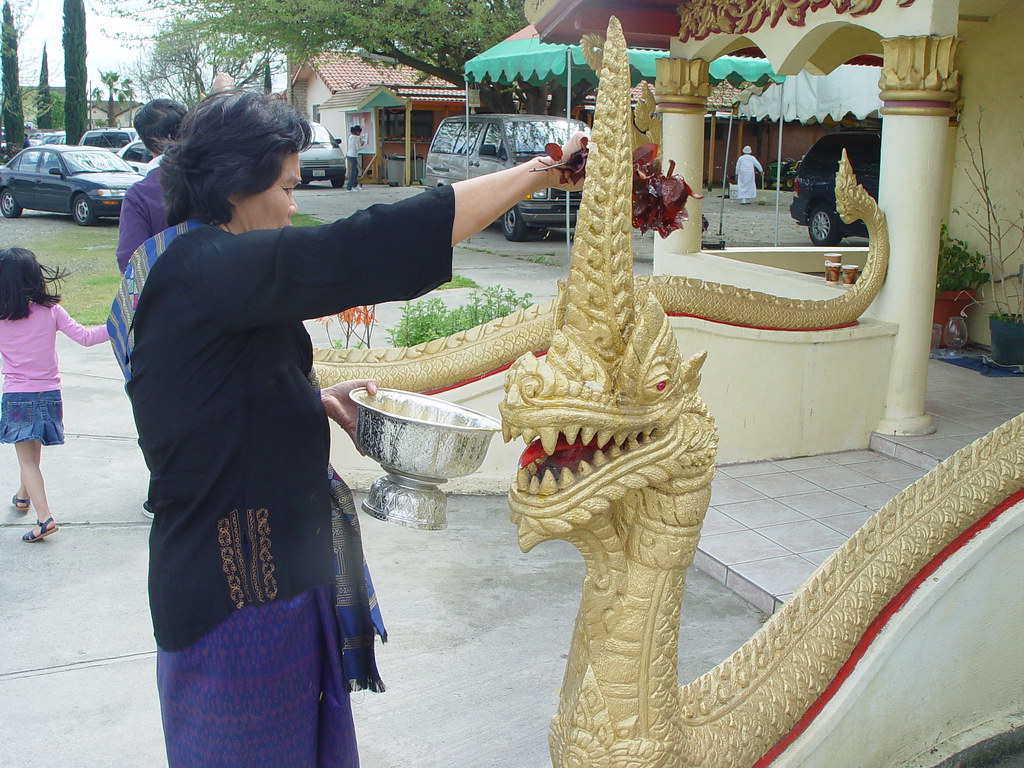

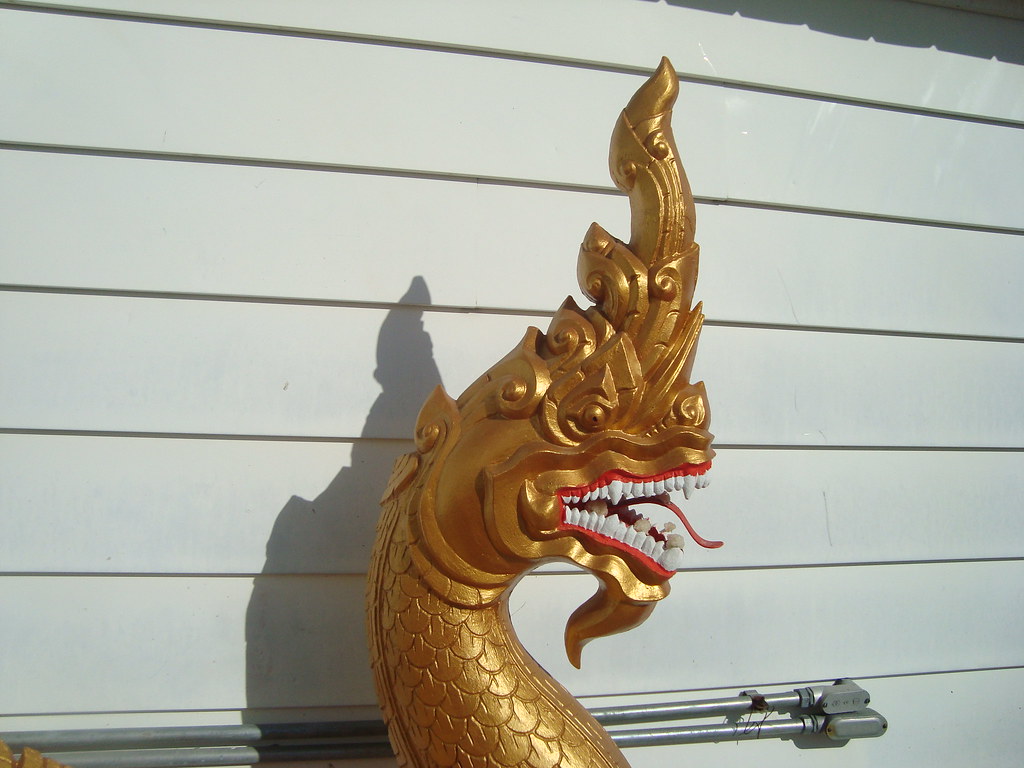
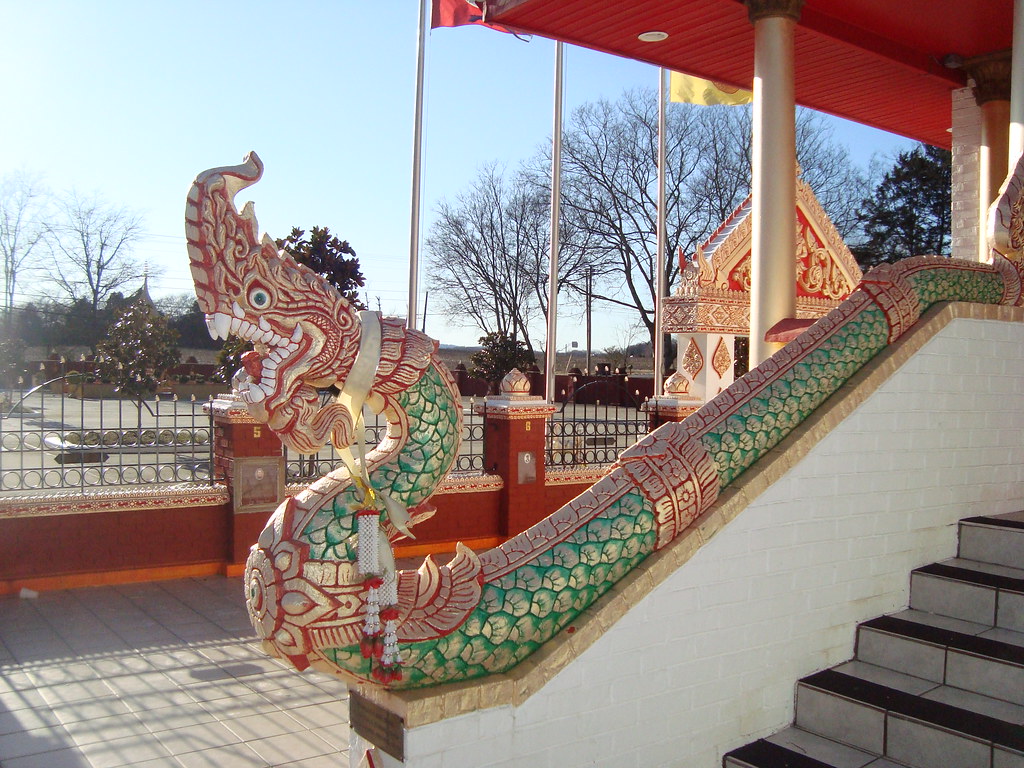
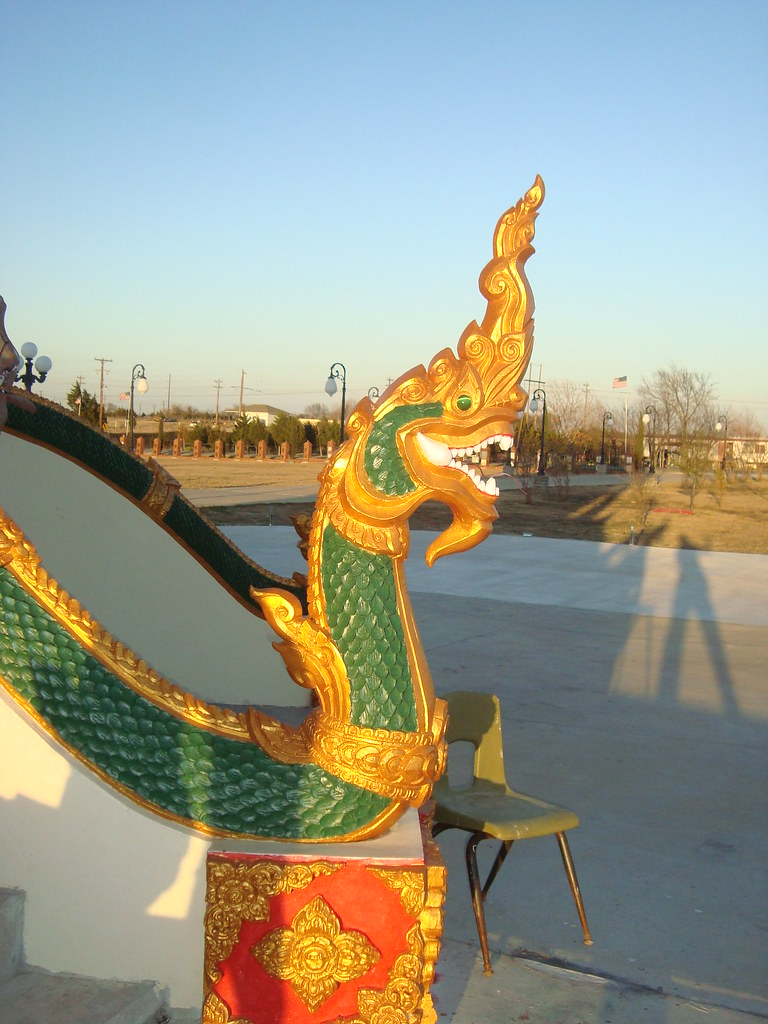 So, what will Vongduane's version look like? She's drawing from many of the traditional descriptions found in classic Lao literature, including epics like Phra Lak Phra Lam, andPhadaeng Nang Ai. We're very excited for this!
So, what will Vongduane's version look like? She's drawing from many of the traditional descriptions found in classic Lao literature, including epics like Phra Lak Phra Lam, andPhadaeng Nang Ai. We're very excited for this!
Also, if we make it to this goal, everyone who's pledged $20 or more will be getting six postcards in the oversized format! Rather than the standard 5.47" x 4.21", the postcards will now be 8.5" x 5.47"
While many of you are familiar with what a Nak is, for our new readers, the Nak, or Naga, is a famous guardian spirit found at temples throughout Laos, who are believed to dwell underground or in pristine waters. Normally, they appear as giant, serpentine entities, but they can also change shape, and have been known to appear as humans and other beings as the occasion requires.
You can find an amazing variety of interpretations of Nak around the world, so we're very excited to see how Vongduane will interpret them. To give you some sense of the extraordinary variety possible, here are some photos of Lao Nak I've taken from across Laos and the United States:






Monday, December 03, 2012
Arts Writers Grant program winners announced
In its 2012 cycle, the Arts Writers Grant Program has awarded a total of $623,500 to twenty-one writers. Ranging from $8,000 to $50,000 in four categories—articles, blogs, books and short-form writing—these grants support projects addressing both general and specialized art audiences, from scholarly studies to self-published blogs.
Articles
Jennifer Krasinski, A Rain Check to Oblivion: A Dispatch from the Jill Johnston Archive (Los Angeles)
Daniel R. Quiles, Counterpublic Access: "The Live! Show" and "TV Party," 1978-1984 (Chicago)
Rebekah Rutkoff, Lillian Schwartz: Light Pen/Paintbrush (Brooklyn)
Blogs
Caryn Coleman, The Girl Who Knew Too Much (Brooklyn)
Farrah Karapetian, Housing Projects (Los Angeles)
Meg Onli, Black Visual Archive (Chicago)
Harbeer Sandhu, Critical Condition (Houston)
Books
Negar Azimi, The Shahbanou and the Iranian Avant-Garde (New York)
Eva Díaz, The Fuller Effect: Contemporary Art and the Critique of Total Design (Brooklyn)
Jennifer Doyle, The Athletic Turn: Contemporary Art and the Sport Spectacle (Los Angeles)
Elena Filipovic, David Hammons’s Bliz-aard Ball Sale (Berlin)
Ara H. Merjian, Pier Paolo Pasolini and the Politics of Art History: Heretical Aesthetics (New York)
Alan W. Moore, Art Squats (Madrid)
Zabet Patterson, Visionary Machines: USCO, Techno-Utopia and Technocracy (Brooklyn)
Abigail Solomon-Godeau, Photography in the Age of Catastrophe (San Francisco)
Michael Taussig, Twilight of the Idols (New York)
Stephen Zacks, A Beautiful Ruin: The Generation that Transformed New York, 1967-1985 (Brooklyn)
Short-Form Writing
Quinn Latimer, Basel, Switzerland
David Rimanelli, New York
Patricia Tumang, Quezon City, Philippines
Harry J. Weil, Brooklyn
Articles
Jennifer Krasinski, A Rain Check to Oblivion: A Dispatch from the Jill Johnston Archive (Los Angeles)
Daniel R. Quiles, Counterpublic Access: "The Live! Show" and "TV Party," 1978-1984 (Chicago)
Rebekah Rutkoff, Lillian Schwartz: Light Pen/Paintbrush (Brooklyn)
Blogs
Caryn Coleman, The Girl Who Knew Too Much (Brooklyn)
Farrah Karapetian, Housing Projects (Los Angeles)
Meg Onli, Black Visual Archive (Chicago)
Harbeer Sandhu, Critical Condition (Houston)
Books
Negar Azimi, The Shahbanou and the Iranian Avant-Garde (New York)
Eva Díaz, The Fuller Effect: Contemporary Art and the Critique of Total Design (Brooklyn)
Jennifer Doyle, The Athletic Turn: Contemporary Art and the Sport Spectacle (Los Angeles)
Elena Filipovic, David Hammons’s Bliz-aard Ball Sale (Berlin)
Ara H. Merjian, Pier Paolo Pasolini and the Politics of Art History: Heretical Aesthetics (New York)
Alan W. Moore, Art Squats (Madrid)
Zabet Patterson, Visionary Machines: USCO, Techno-Utopia and Technocracy (Brooklyn)
Abigail Solomon-Godeau, Photography in the Age of Catastrophe (San Francisco)
Michael Taussig, Twilight of the Idols (New York)
Stephen Zacks, A Beautiful Ruin: The Generation that Transformed New York, 1967-1985 (Brooklyn)
Short-Form Writing
Quinn Latimer, Basel, Switzerland
David Rimanelli, New York
Patricia Tumang, Quezon City, Philippines
Harry J. Weil, Brooklyn
Saturday, December 01, 2012
Last Call for Eye to the Telescope's Asian American Speculative Poetry Issue!
Last Call! As guest-editor of Eye to the Telescope's January issue, I'm looking for Asian American speculative poems (touching on science fiction, fantasy, horror, mythology, etc.)
Eye to the Telescope, a magazine of speculative poetry, is seeking poems drawn from fantasy, science fiction, mythology, and slipstream. Contributors or poem elements should have some connection to Asian America for the January 2013 Issue’s theme on Asian American Speculative Poetry.
Eye to the Telescope is particularly interested in multicultural, multilingual work that brings forward emerging voices, especially from perspectives often underrepresented in existing literature. Work that considers race, gender, sexuality, identity and/or disability issues is welcome. There are no style limitations although shorter works preferred. Submissions should be previously unpublished.
Send work to thaoworra@gmail.com by Dec. 1, 2012 for consideration. http://eyetothetelescope.com
Update:
I'm extending the deadline to Midnight, Dec. 2, 2012, due to special requests.
Eye to the Telescope, a magazine of speculative poetry, is seeking poems drawn from fantasy, science fiction, mythology, and slipstream. Contributors or poem elements should have some connection to Asian America for the January 2013 Issue’s theme on Asian American Speculative Poetry.
Eye to the Telescope is particularly interested in multicultural, multilingual work that brings forward emerging voices, especially from perspectives often underrepresented in existing literature. Work that considers race, gender, sexuality, identity and/or disability issues is welcome. There are no style limitations although shorter works preferred. Submissions should be previously unpublished.
Send work to thaoworra@gmail.com by Dec. 1, 2012 for consideration. http://eyetothetelescope.com
Update:
I'm extending the deadline to Midnight, Dec. 2, 2012, due to special requests.
Friday, November 30, 2012
DEMONSTRA Deluxe Edition Funded!
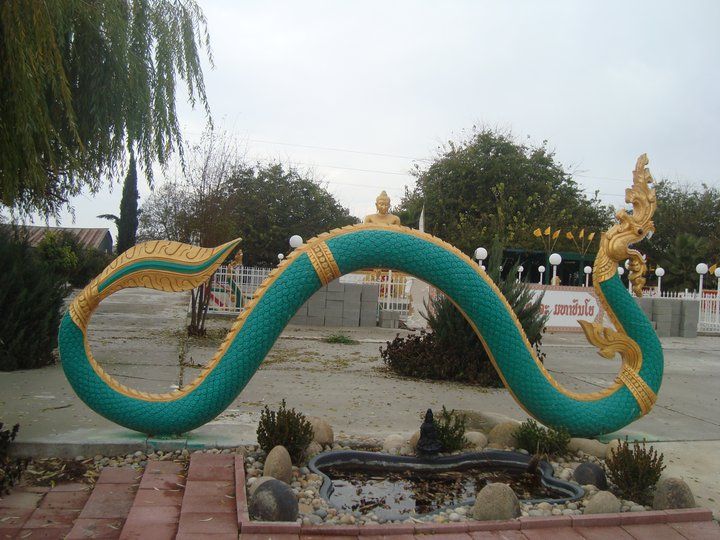
In less than 24 hours we reached our first goal of $500. Vongduane Manivong can now complete 4 of the images for DEMONSTRA. These are the Kinnaly, Vanon, Nyakinee, and Nakanya.
As we overfund, we can add additional rewards to the different reward levels. If we reach $1,000 in funding, we can add the Gop Nyai - the giant frog who eats the moon. At $1,200, we can add Vongduane's take on the Nak, and everyone's postcards get upgraded in size to 8.5" x 5.47".
Please continue to help us spread the word! :)
Our kickstarter to include Lao American art in my new book of poetry is located at http://www.kickstarter.com/projects/1064450543/demonstra-lao-american-art-and-poetry
Lao American Blog: House on the Mekong
One of the Lao American blogs to check out is "House on the Mekong" over at www.houseonthemekong.com, where you can find recipes for Lao dishes as well as stories inspired by the author's family experiences. She would also definitely love your feedback and requests. Please encourage her to keep blogging and helping to build an audience for Lao American arts, cuisine and culture.

Thursday, November 29, 2012
The Demonstra: Deluxe Edition Kickstarter
On November 29th, at 2:22 p.m. we launched our kickstarter to commission Vongduane Manivong to illustrate several of the classic but rarely seen Lao creatures of myth and legend for DEMONSTRA. This funding drive will end on January 1st.
We hope to raise at least $500.
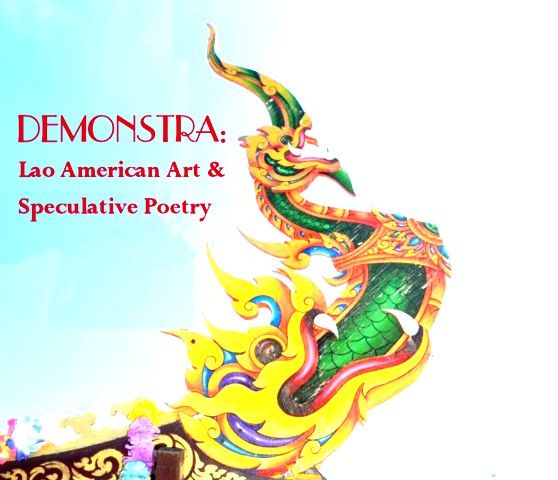
http://www.kickstarter.com/projects/1064450543/demonstra-lao-american-art-and-poetry
We hope to raise at least $500.

http://www.kickstarter.com/projects/1064450543/demonstra-lao-american-art-and-poetry
With your support, acclaimed Lao American artist Vongduane Manivong will provide several interior illustrations to help introduce Lao art, culture and imagination to our readers.
If we can get this project overfunded, we'd be able to commission more than just four pieces for this book, and can offer more exclusive and upgraded extras to everyone who orders in advance.
Tuesday, November 27, 2012
New Layer of Hell / Nalok discovered.
I have determined that HP printers come from a special pit of hell known as the Printerno. FYI: In Lao Nalok, this would most likely be the Hell of Crappy Ink Cartridges and Untimely Paper Jams.
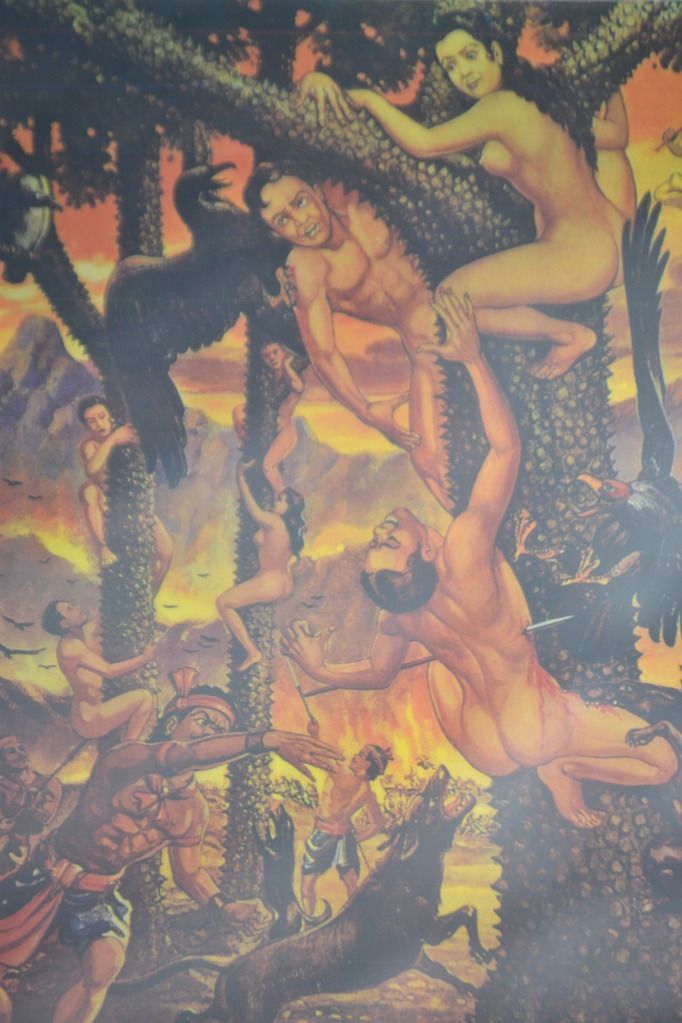
Deadlines, deadlines.
Looking for a new literary journal to subscribe to
So, a certain well-known literary magazine wants me to renew subscription. I like to support literary journals, but after 10 years of giving them a chance, it's clear Lao American voices will never get greenlit by this one. Obviously the answer is "No." But any journals you would recommend?
Anak Sastra Call for Submissions
Anak Sastra seeks short stories (fiction or creative nonfiction) for its 10th issue due out in January 2013. Contributors and/or story themes should have some connection to Southeast Asia. For more information, please visit: www.anaksastra.com.
Monday, November 26, 2012
Journal of Southeast Asian Education and Advancement last call for creative works for 2012
www.jsaaea.org The Journal of Southeast Asian Education and Advancement is taking both non-fiction and creative, literary writing. It is a scholarly, peer-reviewed journal addressing research interests surrounding the education and community development of Southeast Asian Americans. We're accepting the last poems, essays and short stories for the year. Please get them in soon.
Reminder: Eye to the Telescope Submissions due Dec. 1
I'll be guest-editing Eye to the Telescope's January issue, looking for Asian American speculative poems (touching on science fiction, fantasy, horror, mythology, etc.) If you can help me spread the word, I'd appreciate it!
Eye to the Telescope, a magazine of speculative poetry, is seeking poems drawn from fantasy, science fiction, mythology, and slipstream. Contributors or poem elements should have some connection to Asian America for the January 2013 Issue’s theme on Asian American Speculative Poetry.
Eye to the Telescope is particularly interested in multicultural, multilingual work that brings forward emerging voices, especially from perspectives often underrepresented in existing literature. Work that considers race, gender, sexuality, identity and/or disability issues is welcome. There are no style limitations although shorter works preferred. Submissions should be previously unpublished. Send work to thaoworra@gmail.com by Dec. 1, 2012 for consideration. http://eyetothetelescope.com

Eye to the Telescope, a magazine of speculative poetry, is seeking poems drawn from fantasy, science fiction, mythology, and slipstream. Contributors or poem elements should have some connection to Asian America for the January 2013 Issue’s theme on Asian American Speculative Poetry.
Eye to the Telescope is particularly interested in multicultural, multilingual work that brings forward emerging voices, especially from perspectives often underrepresented in existing literature. Work that considers race, gender, sexuality, identity and/or disability issues is welcome. There are no style limitations although shorter works preferred. Submissions should be previously unpublished. Send work to thaoworra@gmail.com by Dec. 1, 2012 for consideration. http://eyetothetelescope.com

Rocket and Lightship

Adam Kirsch in the essay Rocket and Lightship at the Poetry Foundation threw down a pretty volatile gauntlet:
"Literature claims to be a record of human existence through time; it is the only way we have to understand what people used to be like. But this is a basic mistake, if not a fraud, since in fact it only reflects the experience of writers—and writers are innately unrepresentative, precisely because they see life through and for writing. Literature tells us nothing really about what most people’s lives are like or have ever been like. If it has a memorial purpose, it is more like that of an altar at which priests continue to light a fire, generation after generation, even though it gives no heat and very little light."
I do rather like the quote he begins with from G.M. Hopkins: "Nor rescue, only rocket and lightship, shone." This was a line from Hopkins' 1875 long poem “The Wreck of the Deutschland” interestingly composed to "the happy memory of five Franciscan Nuns, exiles by the Falk Laws, drowned between midnight and morning of Dec. 7th, 1875."And then it meanders like hell. (Both the poem and Kirsch' essay.)
I suppose I'm not surprised that Kirsch doesn't draw on writers from a wide range of world traditions. Primarily European and European American writers are cited as he makes his case. And perhaps that was going to be beyond the scope of an essay for the Poetry Foundation. Most of the questions he raises address poetry and literature the way European and American cultures grapple with it. Which isn't a deal-breaker, but I take that into account when reading the parts of it I find readable.
Kirsch asks us to consider that Ezra Pound is wrong. Kirsch notes "Pound’s goal was to “write nothing that we might not say actually in life.” But this is backwards, for nothing memorable is ever said, it is always written; only sometimes it is not written down, but written in the mind so quickly that it can be produced as speech. In speech, the mind is on the moment, the subject, the interlocutor; in writing, the mind is on these and also always on the self, and the appearance the self and its language are making."
There are some fun notions to consider. "Art begins to look like a method of whistling past the graveyard," Kirsch notes, pondering at length on the writer's struggle for posterity, to find a reason to write, given the likely fate of those writings. The sole surviving works of the Roman poet Catullus were found stopping a medieval wine barrel, for example.

Kirsch concludes with "authentic speech and writing are always productive of more speech and writing—indeed, that is the point of discourse, not to describe reality but to avoid silence.
As a Lao American poet, I find this the sort of essay that makes it difficult for me to draw others into the joys and merits of literature. The gulf between experiences and perspective on the world is really difficult to surmount. There are some nuggets of Kirsch well worth considering, that touch on universal questions, but I'm left instead returning back to the sentiments I mentioned in my old poem "Japonisme, Laoisme": "Just write, son." And we'll let history figure the rest out.
Sunday, November 25, 2012
Danh Vo: Winner of the Guggenheim’s Hugo Boss Prize
Vietnamese Berliner Danh Vo is assembling a piece-by-piece, full-scale replica of the Statue of Liberty, in the same copper as the original. Vo was just announced as the winner of the Guggenheim’s Hugo Boss Prize, and will receive $100,000.

(Photo by Nils Klinger, courtesy Galerie Chantal Crousel)
I'm just starting to become familiar with Danh Vo's work, but an immediate response is how different the interpretation of this must be to the respective communities. To whom does it become transgressive and challenging. Is it an homage without any sense of irony? Do we interpret it merely as an interesting technical exercise, or do we take the artist's heritage into account, and the full history of the Statue of Liberty?
I can see this as a statue that is an artistic statement that changes at different points in time. What does it mean for so much of it to be unassembled throughout much of the life of the creator? For those who are living the experience as expat refugees, especially those who aren't living in the United States, but were still displaced by the American War/Vietnam War, does it take on a different significance? What does it signal to those who were born and live in Vietnam?
What would it mean if it was fully assembled in Germany, once the center of the Cold War? What would it mean if it was fully assembled in Vietnam, considering that the original was designed by a French sculptor?
Were it to be assembled in the United States, does it serve as a potent reminder of the most prominent symbol of liberty abroad, or would we see it merely a a novelty like the replica in Las Vegas? Would it throw down the gauntlet to other refugee and immigrant communities in the future, those poor, those tired, those huddled masses, that you really can't be a part of American liberty until you try to build it yourself?
What if it is never assembled at all? A lifetime as essentially, Liberty Disassembled.
Saturday, November 24, 2012
Hugo Munsterberg on photopoetics
“The photopoet must turn to life itself and must remodel life in the artistic forms which are characteristic of his particular art,” film theorist Hugo Münsterberg.
Friday, November 23, 2012
Lao Blog Highlight: The Frog & The Moon
One of the recent blogs that began in March this year is Kelly Phonsinan's The Frog & The Moon: "Musings from a culturally confused Mom, Montessori Teacher, Art Activist and Nature Lover - Happily living in Lao PDR." The blog takes its name from the classic Lao legend for a lunar eclipse.
Be sure to check it out!

Be sure to check it out!

(painting by Kristina Lim)
Tuesday, November 20, 2012
[Poem] Gop Nyai
“Gop kin deaune” or
“The frog is eating the moon”
According to ancient Lao tradition.
Beyond our borders, it’s just a
predictable eclipse.
Carl Sagan would hate our demon-haunted
world.
Sagan has no use for the Lao Sung shaman
near Phonsavan
Who panics when signs suggest Gop Nyai’s
return
Because certain stars are right and dreams
are strange.
If our legends are true,
Somewhere, between Champassak and Luang
Prabang
Hidden deep in a primordial cavern near
the Mekong
He slumbers,
An ancient entity ever dreaming
hungrily,
An anuran astrovore, devouring stars and
celestial bodies.
Perhaps he thinks to gain precious
immortality.
To free himself from bonds of earth and
mere reality.
Each time might be the last time, if not
for humanity
Doing everything to dissuade fearsome
frog ambition.
Towering above our lush jungles and hard
mountains,
He’s selfish with his lunar appetites, an
inconsiderate titan.
His true spawn are terrible to behold,
hungry for man
In indifferent corners best left unknown.
He’s cowardly, despite his size, but
over centuries
Not a single solution has put a final end to him.
Not a single solution has put a final end to him.
So, men, women and children keep
watching the skies,
Laughing nervously, trying not to take anything
for granted.
Living
loud and proud, to protect the cosmos, just in case.
Monday, November 19, 2012
[Neologism] Sociopatsy
Because no one else has begun the discussion on it in earnest anywhere on the web, I hereby coin the term: Sociopatsy. The jerk who takes the fall for some other sociopath's misanthropy.
[Poem] Kwam Yan: A Dharma Discourse
Ajahn Anan always wants to frame
Five famed precepts of Buddhism
In a way tomorrow’s Lao parents
Will appreciate and happily pass on
Without any more snoring
During our daily meditation.
He experiments on occasion in Cali:
The first precept in Pali is the lengthy
Pānātipātā veramanī sikkhāpadam samādiyāmi.
"Don’t take life." So, most monsters
Would not make good monks.
Especially a menace who kills gleefully,
Offering no justification for their bad manners.
The thin road to nibbana is not observed easily
With a bloody hand, an obscene heart of malice.
Adinnādānā veramanī sikkhāpadam samādiyāmi.
Even in the aftermath of an apocalypse,
Such as nations falling into the sea,
Or a blight of rampaging zombies,
Looting stains one’s karma permanently.
It's worse when one's a thief with no emergency.
"What goes around comes around,
Even if it seems like the world’s end."
For precept number three:
Kāmesumicchācāra veramanī sikkhāpadam samādiyāmi.
If one is being chased by malevolent jungle predators
Or lounging leisurely among many lovely alien beauties,
Knowing not to engage in improper promiscuity
Is a mark of wisdom and aids survivability.
"This should be clear as a crystal lake."
Musāvādā veramanī sikkhāpadam samādiyāmi
"Do not lie. Treasure honesty."
In our world of shapeshifters,
The desperate, despicable despots,
And a thousand sneaky phi,
Trust can be hard to gain easily.
In the old days, if you found yourself on the run,
Being known for your kindness and good word
Got you farther than just a sharp sword or a gun.
Observing precept number five can keep you alive.
Surāmerayamajjapamādatthānā veramanī
sikkhāpadam samādiyāmi is admittedly
A long way to say “avoid drunkenness or highs.”
Getting red-faced or stoned invites reckless drama,
Increasing your odds of discovering various ways to die,
Or breaking other vows you once intended sincerely.
Often quite embarrassingly.
"Don't meet your fate clumsily tripping," he advised.
Incidentally, he discouraged drinking old snake venom,
Rancid bull bits, bear bile or tiger pee.
"Fear should not be what brings you
To a righteous path," Ajahn insists.
There are profound reasons the rules exist.
“Don’t make this sound like a fortune cookie,”
He pleads. “If people pay attention properly,
You’ll only hear this in one last life.”
He excused himself in time
For the next prayers for an impermanent world.
Thursday, November 15, 2012
Luang Prabang Film Festival Kickstarter
The Luang Prabang Film Festival has launched a last-minute kickstarter to raise $10K with 13 days left to go. If you can pitch in, please consider it! I know they'd appreciate it.


You Will Not Go To Space Today

Well, there are no Lao entries here yet, so there's still hope for the Lao Space Program. But in the meantime, the promising tumblr "You Will Not Go To Space Today."
Wednesday, November 14, 2012
Lao Cooking: Smoky Ghost Ketchup
The following recipe should make a smoky ghost ketchup good with fries, burgers, sloppy joes, meatloaf, and other dishes. You should probably warn people if you are adding this to the table.
Ingredients
2 cups mesquite chips
1 head garlic
5 plum tomatoes, seeded and halved
2 Fantome du Laos tomatoes, seeded
1 small yellow onion, peeled into rings
2 small shallots, peeled and halved
1 ghost pepper, seeded and cut in half
Vegetable cooking spray
2 (8-ounce) cans no-salt tomato sauce
1/2 teaspoon salt
1/4 teaspoon black pepper
Preparation
Soak mesquite chips in water at least 30 minutes; drain.
Peel outer skins from garlic; cut off and discard top third of garlic head. Place garlic, tomato halves (cut side down), and onion, shallots, and ghost pepper into a grill basket.
Pile charcoal on each side of grill, leaving the center empty, with a drip pan between coals. Ignite fire; let burn 10 to 15 minutes. Place half of mesquite chips onto hot coals.
Coat the grill rack with cooking spray, and place over coals. Place the grill basket on rack over the drip pan; cover and cook 30 minutes.
Turn vegetables, and add your remaining mesquite chips to the hot coals. Cover and cook for 30 minutes or until vegetables are tender and lightly browned. Remove the vegetables from grill. Squeeze out pulp from garlic. Put garlic pulp, vegetables, tomato sauce, and remaining ingredients into a food processer and puree until its smooth.
Ingredients
2 cups mesquite chips
1 head garlic
5 plum tomatoes, seeded and halved
2 Fantome du Laos tomatoes, seeded
1 small yellow onion, peeled into rings
2 small shallots, peeled and halved
1 ghost pepper, seeded and cut in half
Vegetable cooking spray
2 (8-ounce) cans no-salt tomato sauce
1/2 teaspoon salt
1/4 teaspoon black pepper
Preparation
Soak mesquite chips in water at least 30 minutes; drain.
Peel outer skins from garlic; cut off and discard top third of garlic head. Place garlic, tomato halves (cut side down), and onion, shallots, and ghost pepper into a grill basket.
Pile charcoal on each side of grill, leaving the center empty, with a drip pan between coals. Ignite fire; let burn 10 to 15 minutes. Place half of mesquite chips onto hot coals.
Coat the grill rack with cooking spray, and place over coals. Place the grill basket on rack over the drip pan; cover and cook 30 minutes.
Turn vegetables, and add your remaining mesquite chips to the hot coals. Cover and cook for 30 minutes or until vegetables are tender and lightly browned. Remove the vegetables from grill. Squeeze out pulp from garlic. Put garlic pulp, vegetables, tomato sauce, and remaining ingredients into a food processer and puree until its smooth.
Tuesday, November 13, 2012
Design Notes for "The Dream Highway of Ms. Mannivongsa"
Still a work in progress, the following are some of the thoughts informing the different sections of "The Dream Highway of Ms. Mannivongsa" which will be appearing in my new book DEMONSTRA, in April 2013.
You will see many of these principles at work in my forthcoming poem "Stainless Steel Nak" coming out in Lontar next year.
A few of my students and other writers may find this helpful to see what's going on here, under the hood. And hopefully readers will find encouragement to explore the world of poetry with your own techniques.
Fluid Laoglish
I consider my audience a global one. I write primarily in what I consider "Fluid Laoglish." Amazingly, in some places, people freak out if a poem incorporates even a word of Laoglish. But that's where poets come in, to set the balance right.
What the use of "Fluid Laoglish" means is that in a poem, the romanization of a Lao word may change to fit the visual need of the poem in order to execute a polylingual word play. A good poem to me works well being heard or being seen. This isn't absolute, but it's a good benchmark to begin with.
A case in point regarding fluid Laoglish can be seen when making reference to the old kingdom of Lan Xang vs. Lane Xang. While it is more common to see it written as Lan Xang, in a passage where we're also writing about roads, "Lane" is the spelling I might choose.
Other words might include the Lao word for spirits: Phi, Pi, Pee, etc. which can have a different meaning in other languages.
I'm aware the more common term for Nak is Naga, but I'd encourage more Lao writers to use the Lao spelling and bring it into common parlance. And definitely don't call it a dragon. There was a time no one knew what a vampire was, or a werewolf, a zombie, or a mummy. Will Nak ever become the preferred term in the world? Who knows. But just as Aloha or Hola has joined the world as one of many ways one can greet another human, we shouldn't shy away from our own way of saying things.
It will probably be a while before Arnold Schwarzenegger says"Sabaidee, Baby," the way he says "Hasta La Vista," but if you don't offer it as an option, people don't get a chance to try for themselves.
Italics
I use italics for book/work titles, whether English or non-English. For example: Gone with the Wind or The Ramayana or Turandot.
I don't use italics for words that are perceived as "The Other," because what's a foreign, alien word anymore? Taco, sushi, ninja, rendezvous, caucus, karaoke, avatar? If you don't italicize these, then you don't italicize Lao words except for emphasis.
Rhyme
Rhyme is subordinate to image and idea I appreciate my international audience, and especially the work of my translators. And anyone who's worked in a multilingual setting can tell you that it's very difficult to translate poets whose work is heavily dependent on rhyme to achieve its aesthetic.
What rhymes in Lao loses a lot if you try to reproduce that rhyme in English, or Spanish, or German, or French or Korean. I'd rather have a strong image, a strong concept in a poem that can be translated in many different ways without some poor soul stressed that the spirit has been captured, but not the form.
However, that doesn't mean that I eschew rhyme, and in a poem like "The Dream Highway of Ms. Mannivongsa" I employ what has been jokingly referred to as TRAmbiguous rhyme, after my experience as transcultural adoptee and the ambiguities that come with such a life.
This means when the reader comes across an uncertain set of words, they can look at a nearby line to guess what the word rhymes with. But a TRAmbiguous rhyme also includes another line that allows for a nice rhyme the other way.
As an immediate example in this latest poem:
"She remembered Los Alamos just fine, but not the Axolotl poem by Arthur Sze
Or why “Traduttore, traditore” is an accepted way to betray, among the literary.
The local fungi taste funny, but why, she cannot precisely say."
Does Arthur Sze rhyme with "literary" or "say"? Certainly for some there's a definitive answer, but for others who've never met him, it could go either way. And it won't hurt the flow. Of course, there's some linguistic purist who will probably hate this, but they can go write their own poem, then.
Allusion and Wordplay
In "The Dream Highway of Ms. Mannivongsa" you might not catch all of the allusions and references in the poem until a highly annotated version comes out. Much like George Lucas threw you "In Media Res" or "in the middle of the action," so, too, I think readers can have a fun, rollicking time filling in the blanks or googling up a term on their own time to see what they get.
You might not recognize space coyote, or H.P. Lovecraft's moonbeasts, or the appearance of certain popular vampires of the last thirty years, but as a poet, I hope to have provided just enough of a 'toolkit' that you can get what it probably is.
For example:
"There is no Wat Lao to get married in by Ajahn Elvis."
Here, I hope you can figure out that a Wat Lao is like the Chapel of Love, a synagogue, a church, or what have you. In another line of the poem, you don't have to know how to make really dirty tom mak hung, but just trust that it's Ms.Mannivongsa's father's favorite dish.
Will you get something extra out of knowing the lyrics of "O Fortuna" or the plot of Turandot? Yes, but it's not strictly necessary to appreciate the whole of the story. When we make a reference to the creepy little girl courier on the beach in California named "Psycho Pom" in Ms. Mannivongsa's dream, you can know that a psychopomp is a mythological guide who takes you through the underworld, but you can live just fine knowing that Pom is sometimes a Lao girl's name.
I hope you enjoyed this quick peek at the design for "The Dream Highway of Ms. Mannivongsa." This post is where I'll field any other questions you might have on the process.
You will see many of these principles at work in my forthcoming poem "Stainless Steel Nak" coming out in Lontar next year.
A few of my students and other writers may find this helpful to see what's going on here, under the hood. And hopefully readers will find encouragement to explore the world of poetry with your own techniques.
Fluid Laoglish
I consider my audience a global one. I write primarily in what I consider "Fluid Laoglish." Amazingly, in some places, people freak out if a poem incorporates even a word of Laoglish. But that's where poets come in, to set the balance right.
What the use of "Fluid Laoglish" means is that in a poem, the romanization of a Lao word may change to fit the visual need of the poem in order to execute a polylingual word play. A good poem to me works well being heard or being seen. This isn't absolute, but it's a good benchmark to begin with.
A case in point regarding fluid Laoglish can be seen when making reference to the old kingdom of Lan Xang vs. Lane Xang. While it is more common to see it written as Lan Xang, in a passage where we're also writing about roads, "Lane" is the spelling I might choose.
Other words might include the Lao word for spirits: Phi, Pi, Pee, etc. which can have a different meaning in other languages.
I'm aware the more common term for Nak is Naga, but I'd encourage more Lao writers to use the Lao spelling and bring it into common parlance. And definitely don't call it a dragon. There was a time no one knew what a vampire was, or a werewolf, a zombie, or a mummy. Will Nak ever become the preferred term in the world? Who knows. But just as Aloha or Hola has joined the world as one of many ways one can greet another human, we shouldn't shy away from our own way of saying things.
It will probably be a while before Arnold Schwarzenegger says"Sabaidee, Baby," the way he says "Hasta La Vista," but if you don't offer it as an option, people don't get a chance to try for themselves.
Italics
I use italics for book/work titles, whether English or non-English. For example: Gone with the Wind or The Ramayana or Turandot.
I don't use italics for words that are perceived as "The Other," because what's a foreign, alien word anymore? Taco, sushi, ninja, rendezvous, caucus, karaoke, avatar? If you don't italicize these, then you don't italicize Lao words except for emphasis.
Rhyme
Rhyme is subordinate to image and idea I appreciate my international audience, and especially the work of my translators. And anyone who's worked in a multilingual setting can tell you that it's very difficult to translate poets whose work is heavily dependent on rhyme to achieve its aesthetic.
What rhymes in Lao loses a lot if you try to reproduce that rhyme in English, or Spanish, or German, or French or Korean. I'd rather have a strong image, a strong concept in a poem that can be translated in many different ways without some poor soul stressed that the spirit has been captured, but not the form.
However, that doesn't mean that I eschew rhyme, and in a poem like "The Dream Highway of Ms. Mannivongsa" I employ what has been jokingly referred to as TRAmbiguous rhyme, after my experience as transcultural adoptee and the ambiguities that come with such a life.
This means when the reader comes across an uncertain set of words, they can look at a nearby line to guess what the word rhymes with. But a TRAmbiguous rhyme also includes another line that allows for a nice rhyme the other way.
As an immediate example in this latest poem:
"She remembered Los Alamos just fine, but not the Axolotl poem by Arthur Sze
Or why “Traduttore, traditore” is an accepted way to betray, among the literary.
The local fungi taste funny, but why, she cannot precisely say."
Does Arthur Sze rhyme with "literary" or "say"? Certainly for some there's a definitive answer, but for others who've never met him, it could go either way. And it won't hurt the flow. Of course, there's some linguistic purist who will probably hate this, but they can go write their own poem, then.
Allusion and Wordplay
In "The Dream Highway of Ms. Mannivongsa" you might not catch all of the allusions and references in the poem until a highly annotated version comes out. Much like George Lucas threw you "In Media Res" or "in the middle of the action," so, too, I think readers can have a fun, rollicking time filling in the blanks or googling up a term on their own time to see what they get.
You might not recognize space coyote, or H.P. Lovecraft's moonbeasts, or the appearance of certain popular vampires of the last thirty years, but as a poet, I hope to have provided just enough of a 'toolkit' that you can get what it probably is.
For example:
"There is no Wat Lao to get married in by Ajahn Elvis."
Here, I hope you can figure out that a Wat Lao is like the Chapel of Love, a synagogue, a church, or what have you. In another line of the poem, you don't have to know how to make really dirty tom mak hung, but just trust that it's Ms.Mannivongsa's father's favorite dish.
Will you get something extra out of knowing the lyrics of "O Fortuna" or the plot of Turandot? Yes, but it's not strictly necessary to appreciate the whole of the story. When we make a reference to the creepy little girl courier on the beach in California named "Psycho Pom" in Ms. Mannivongsa's dream, you can know that a psychopomp is a mythological guide who takes you through the underworld, but you can live just fine knowing that Pom is sometimes a Lao girl's name.
I hope you enjoyed this quick peek at the design for "The Dream Highway of Ms. Mannivongsa." This post is where I'll field any other questions you might have on the process.
Cooking: Lao American Spirit Salsa
Named because it incorporates both the ghost pepper and the Fantome du Laos tomatoes, which are said to glow on the vine at night when spirits are present.
2 mangos, peeled and chopped
2 small peaches, halved and diced into 1/2-inches
2 Fantome du Laos tomatoes, chopped
2 Beefmaster tomatoes, chopped
1/4 to 1/2 Ghost Pepper (Naga Bhut Jolokia) thinly diced.
1 white onion, diced
1 red bell pepper, diced
1 yellow bell pepper, diced
1 cup fresh pineapple, diced
1 cup fresh cilantro, chopped
1 clove garlic, minced
2 tablespoons lime juice
1 teaspoon fish sauce or salt
2 tablespoons white sugar, or to taste
3/4 cup coconut water
Place the mango, peach, tomatoes, ghost peppers, onion, red pepper, yellow pepper, pineapple, and cilantro in a mixing bowl. Stir in the garlic, lime juice, fish sauce or salt, sugar, and coconut water. Cover and refrigerate at least 1 hour before serving. And watch out for ghosts, obviously.
2 mangos, peeled and chopped
2 small peaches, halved and diced into 1/2-inches
2 Fantome du Laos tomatoes, chopped
2 Beefmaster tomatoes, chopped
1/4 to 1/2 Ghost Pepper (Naga Bhut Jolokia) thinly diced.
1 white onion, diced
1 red bell pepper, diced
1 yellow bell pepper, diced
1 cup fresh pineapple, diced
1 cup fresh cilantro, chopped
1 clove garlic, minced
2 tablespoons lime juice
1 teaspoon fish sauce or salt
2 tablespoons white sugar, or to taste
3/4 cup coconut water
Place the mango, peach, tomatoes, ghost peppers, onion, red pepper, yellow pepper, pineapple, and cilantro in a mixing bowl. Stir in the garlic, lime juice, fish sauce or salt, sugar, and coconut water. Cover and refrigerate at least 1 hour before serving. And watch out for ghosts, obviously.
Interviewed by Rebecca Brown
I was recently interviewed by Rebecca L. Brown, who is a British genre writer based in Cardiff, South Wales. There, she dwells with a most peculiar menagerie that includes her partner. She also has a background in archaeology and a terrible sense of direction. That being said, I had a lot of fun being interviewed for her ongoing Somebody Else's Writing series. Thanks, Rebecca, and I'm looking forward to seeing your next books!


Sunday, November 11, 2012
Laomerican cooking: BeerLao Ghost Cheese Soup!
Just in time for Thanksgiving, we're kicking up the traditional Beercheese soup Lao style. Give it a try if you dare. Not for the lactose intolerant, obviously. And it will live up to the mantra 'goes in hot, comes out hot' but go figure.
Ingredients
1 (12-ounce) BeerLao of choice
1/2 cup butter
1 chopped medium sized yellow onion
At least 1/2 cup chopped carrot
At least 1/2 cup chopped celery
1 cup all-purpose flour
2 cups chicken broth
7 ounces extra-sharp Cheddar, shredded (Aged 8 to 10 years+ is awesome)
7 ounces processed Swiss cheese, shredded
2 cups half-and-half
1/2 teaspoon salt
1/2 teaspoon dry mustard
1/2 teaspon dijon mustard
1/2 teaspoon Worcestershire sauce
1/2 to 1 whole Ghost pepper
Sriracha to taste
Optional: 1 pound smoked sausage (recommended: spicy Lao sausage, or smoked bratwurst if your local Lao sausage distributors stink. (Not naming names...)
Directions
In a large saucepan over medium heat, stir together carrots, onion, celery, and garlic. Stir in ghost pepper, salt, and pepper. Pour in chicken broth and beer; simmer until vegetables are tender, about 12 minutes. Remove from heat.
Meanwhile, heat butter in a large soup pot over medium-high heat. Stir in flour with a wire whisk; cook, stirring until the flour is light brown, about 3 or 4 minutes. Gradually stir in milk, whisking to prevent scorching, until thickened. Remove from heat, and gradually stir in cheese. Keep warm.
Stir beer mixture into cheese mixture. Stir in Dijon mustard, Worcestershire sauce, and dry mustard. Adjust for sriracha sauce to taste. Bring to a simmer, and cook 10 minutes. Serve topped with popcorn or croutons / toasted baguette with garlic butter.
Ingredients
Directions
Saturday, November 10, 2012
Laos Free: Almost complete
A few months back, Cory Sheldon did a kickstarter for an animated project called Laos Free. It would be an animated film addressing the UXO issues in Laos since the end of the US bombing campaign during the 1960s and 70s. He recently finished it, except for a few minor tweaks. Having seen a preview of it, I can say that it's touching and well-done.
In his project description, he mentioned that he "wanted to show life in Laos, as it is today and how it was during the bombing. I felt that animation was perhaps the only way to really do this. There is very little photographic or film documentation of the situation from the perspective on the ground, so the only accounts I have access to come from the illustrations or survivor testimony."
I think what he accomplished will move many hearts, and hopefully provide people with a great way to begin meaningful conversations about what we can do to create a peaceful legacy in the aftermath of the war. Keep an eye out for it.
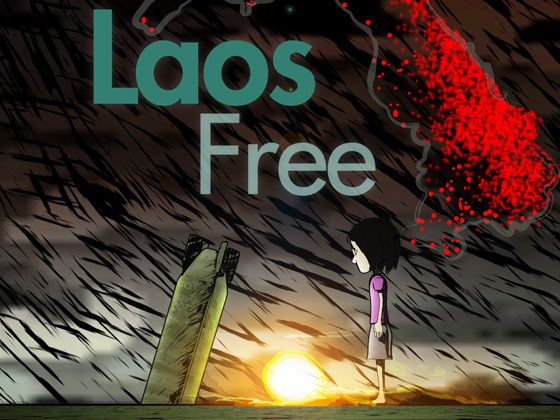
In his project description, he mentioned that he "wanted to show life in Laos, as it is today and how it was during the bombing. I felt that animation was perhaps the only way to really do this. There is very little photographic or film documentation of the situation from the perspective on the ground, so the only accounts I have access to come from the illustrations or survivor testimony."
I think what he accomplished will move many hearts, and hopefully provide people with a great way to begin meaningful conversations about what we can do to create a peaceful legacy in the aftermath of the war. Keep an eye out for it.

Friday, November 09, 2012
Thursday, November 08, 2012
Arn Chorn-Pond and "Never Fall Down,"
The story of a Cambodian author adoptee from the Killing Fields era was featured in the Boston Globe this week. He witnessed the murders as a youth, was resettled in the US, and as an adult, returned to live in Cambodia in a home where he mentors 8 homeless children and overseas reach out music programs in remote areas.
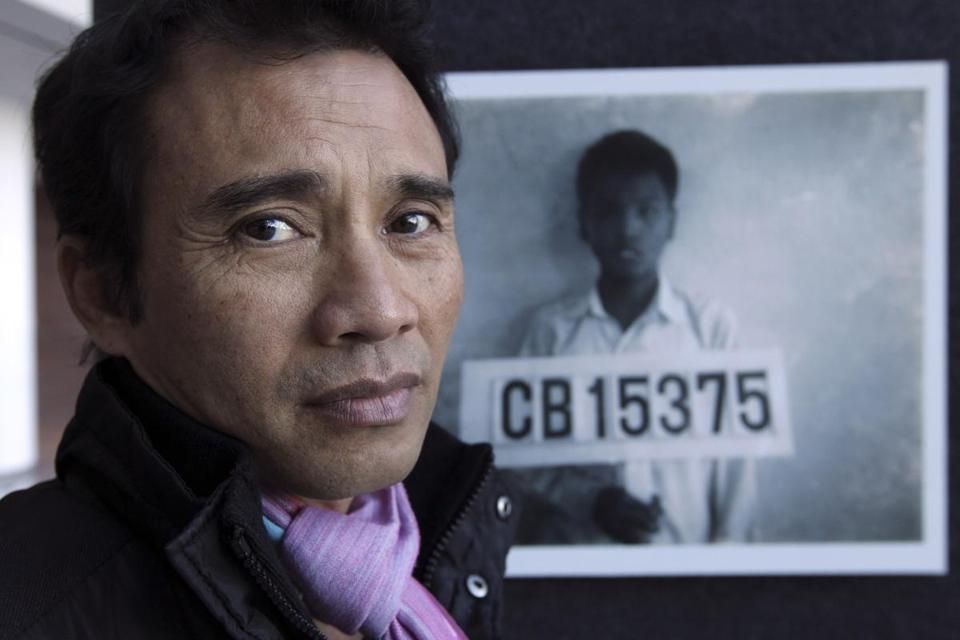

Call for Submissions: Eye to the Telescope
I'll be guest-editing Eye to the Telescope's January issue, looking for Asian American speculative poems (touching on science fiction, fantasy, horror, mythology, etc.) If you can help me spread the word, I'd appreciate it!
Eye to the Telescope, a magazine of speculative poetry, is seeking poems drawn from fantasy, science fiction, mythology, and slipstream. Contributors or poem elements should have some connection to Asian America for the January 2013 Issue’s theme on Asian American Speculative Poetry.
Eye to the Telescope is particularly interested in multicultural, multilingual work that brings forward emerging voices, especially from perspectives often underrepresented in existing literature. Work that considers race, gender, sexuality, identity and/or disability issues is welcome. There are no style limitations although shorter works preferred. Submissions should be previously unpublished. Send work to thaoworra@gmail.com by Dec. 1, 2012 for consideration. http://eyetothetelescope.com
Eye to the Telescope, a magazine of speculative poetry, is seeking poems drawn from fantasy, science fiction, mythology, and slipstream. Contributors or poem elements should have some connection to Asian America for the January 2013 Issue’s theme on Asian American Speculative Poetry.
Eye to the Telescope is particularly interested in multicultural, multilingual work that brings forward emerging voices, especially from perspectives often underrepresented in existing literature. Work that considers race, gender, sexuality, identity and/or disability issues is welcome. There are no style limitations although shorter works preferred. Submissions should be previously unpublished. Send work to thaoworra@gmail.com by Dec. 1, 2012 for consideration. http://eyetothetelescope.com
Tuesday, November 06, 2012
Discussing 1984 in Hemet, November 10th

As a reminder, the Doing Literature book discussion group’s 11th season continues at the Hemet Public Library. This month will feature a discussion of George Orwell’s dystopian classic “1984” on November 10th at 10:00AM. Remember: It was intended as a warning, not an instruction manual.
On December 8th, the group will discuss French writer Marguerrite Duras’ “The Lover”. What do these books have in common, why do they endure and how do they connect to the lives of Hemet residents today?
Bring your thoughts and ideas every second Saturday at the Hemet Public Library at 300 East Latham Avenue. For more information e-mail thaoworra@gmail.com or twitter @hemetliterature
[Poem] Khao Jai

In the spirit of Election Day:
Khao Jai
Enter the heart and you understand.
To be jai yen, my heart cool, without worries,
I smile like a nak, a rainbow bridge, a June rain,
Trying to find a middle path I‟m happy with:
I've seen how much difference one person can make.
I don‟t want anyone to fall behind in our beautiful city.
As a writer, I never want a title, a grade or a sheet of paper
To hold a soul back from
All of the good they can do in the world.
A head of knowledge is worth more than a tray full of gold and jewels.
But every head is unique and capable of generosity.
Some will learn everything they need in life from a book,
But others will find a page inadequate even in the schools of Sihome.
Some discover galaxies in the motion of a single human body.
Others can gaze at the finest dancers of Vientiane and remain unchanged.
There are those whose greatest teachers are a touch.
Some can be blind and with a single piano, move nations.
Some must discover on their own, free of desks and distraction.
We fail the world, ourselves, if we don‟t seek the best for one another,
If we're unkind to someone whose only crime is they aren't like us,
Or they make their way through the world by a different road than ours.
But I‟m just a nuckawii.
There are people in the world who trained a lifetime
To change things so much better than I, the silapin or a laughing nak dontii.
And any day now, they'll do their job properly.
Will Lao Minnesotans vote No-No?

Reprinting my op-ed that appeared in the Twin Cities Daily Planet: "Will Lao Minnesotans vote No-No?" Little Laos on the Prairie also recently published an opinion: "Why Little Laos is Voting ‘No’ this ‘No’vember" and the Lao Assistance Center's open letter to the community from executive director Sunny Chanthanouvong. Be sure to check those out. Hopefully other Lao Americans have been chiming in across the rest of the country on issues that matter to them, too.
Here's my take.
Will Lao Minnesotans Vote No-No?
Election day is around the corner, but where are Lao Minnesotan voices?
I was naturalized on Flag Day in 1976, the American Bicentennial. Since then, I've always taken my citizenship seriously. My family has always reminded me that many men and women fought and died to preserve our democratic freedoms in America, and to assist others who are trying to live free of fear and tyranny abroad.
For Lao Americans who came to the US as refugees, our heritage obliges us to remember and vindicate those sacrifices through good citizenship. And part of good citizenship is participating, not just once a year voting, but regularly communicating with your representatives, and taking a stand on what matters to you.
I think it's well known: I don't speak for all Lao Americans. But I am a Lao American voice.
And I have been hoping, through this forum and others, that we would see a growth in Lao Americans taking a public stand and demonstrate courage to express their convictions. Because that's what makes a democracy function, and a nation great.
I'm surprised how quiet Lao Minnesotans have been in the media about both the Marriage Amendment and the Voter ID laws.
Especially since some of the strongest Lao American GLBT writers and editors in the country live in Minnesota. And Minnesota is home to many nationally-recognized artists, educators and community builders. These are former refugee families who, more than most, should be making it clear that laws that restrict diversity, that make it harder to participate in democracy have no place in Minnesota culture.
I've been waiting to see our Lao Minnesotan civic leaders, our organizations, families and students go beyond the "get out and vote" efforts and to actually take positions that they would defend. To express ourselves, as is our right, without fear of intimidation or retaliation. We must speak, or we will be spoken for.
Or worse, as is more likely the case, we will not even be considered at all, as we saw with the stunning exclusion of Lao Americans in the recent report from the National Asian American Survey entitled “Public Opinion Of a Growing Electorate: Asian Americans and Pacific Islanders in 2012”.
Although they're taking steps to correct it now, in that report, the researchers claim Lao American voices were wanted, but none of the professional survey companies could conduct the survey in Lao, even though 70% of Lao Americans speak English well. And how many years did it take for the Twin Cities World Refugee Day website to include a mention of the Lao, even though we've been here for over 30 years as your friends and neighbors?
I don't think my heart was ever as broken as the day I took Lao Minnesotan youth to the State Capitol to visit their representatives a few years ago. Despite all of the encouragement, almost no one had the courage to talk, to even say hi, let alone ask a politician to support something as non-controversial as improving education in Minnesota's schools.
Considering the latest Council on Asian Pacific Minnesotans' report that Lao Minnesotan children have reading score of 56.9% and a math score of 39.7%, even for children born and raised here all of their lives, I think that would have been a pretty darn reasonable request.
And deep down, I found myself hating, hating whatever it was that filled these young children with fear, that taught them to remain silent, to not 'rock the boat', to never speak their hearts. The late Sentaor Paul Wellstone famously said, "We all do better when we all do better." And that comes from expressing ourselves, even in public.
I'm not asking for us to all agree on all of the issues all of the time. Quite the contrary, I want plurality. I want to see opinions that challenge our assumptions, that give us a clear view of all our options, and where we might go with those ideas, great and small. But that doesn't work if we don't speak up. And sometimes, that means saying "No" to bad ideas. Or even "No and No."
The author W. Somerset Maugham had it right when he pointed out "If a nation values anything more than freedom, it will lose its freedom; and the irony of it is that if it is comfort or money that it values more, it will lose that too."
Subscribe to:
Posts (Atom)



